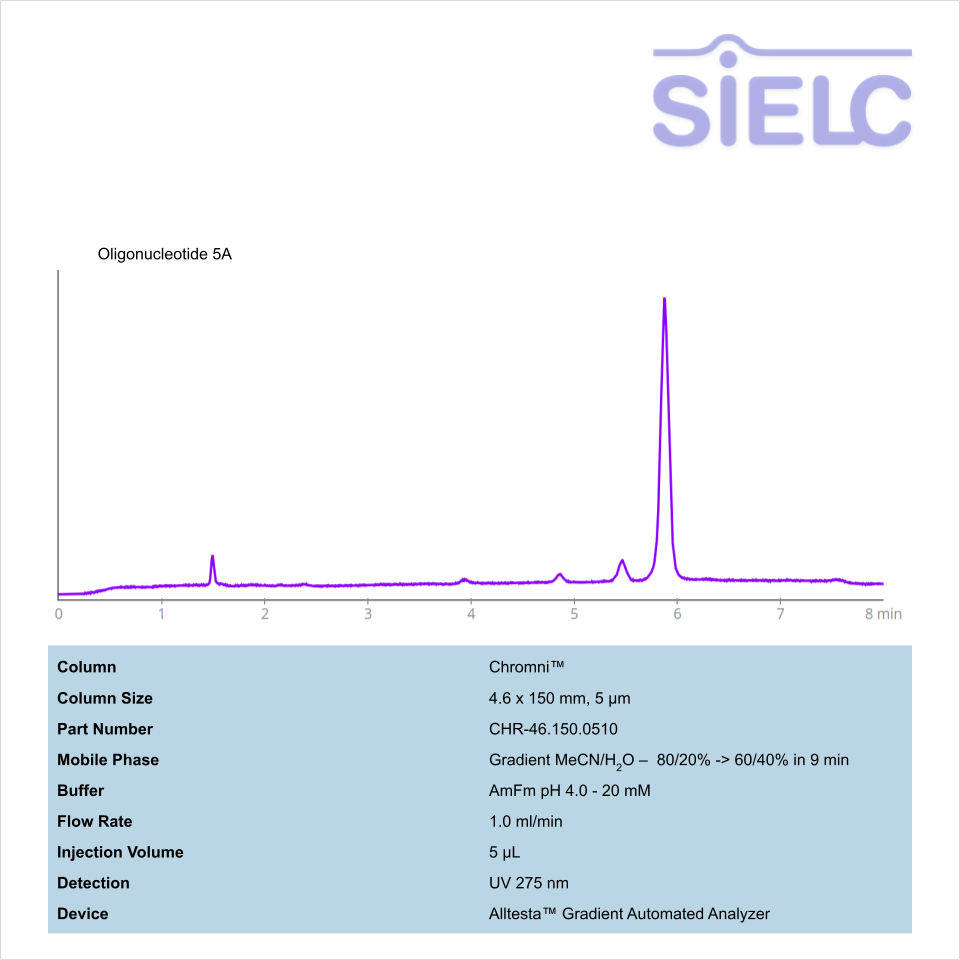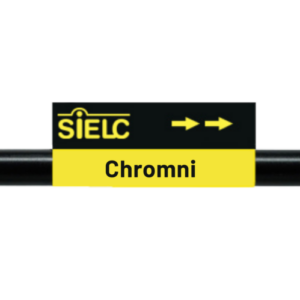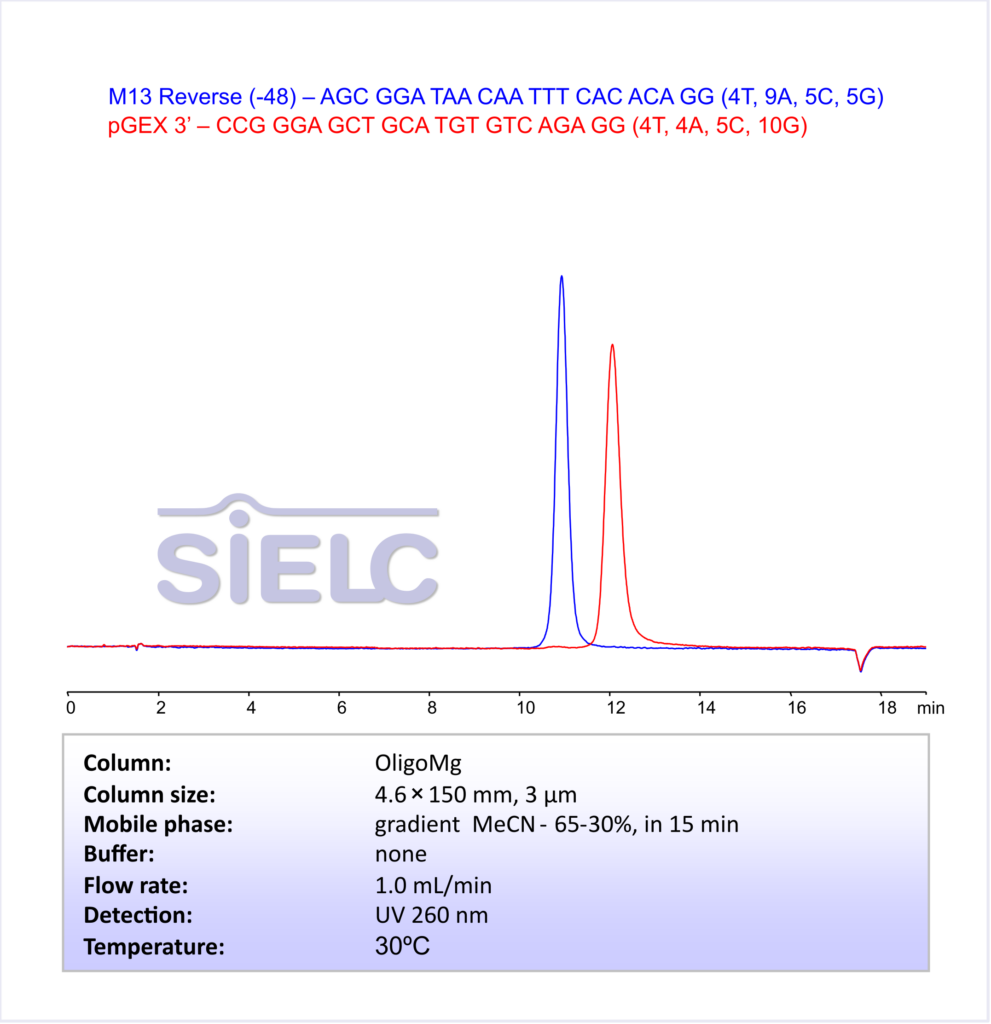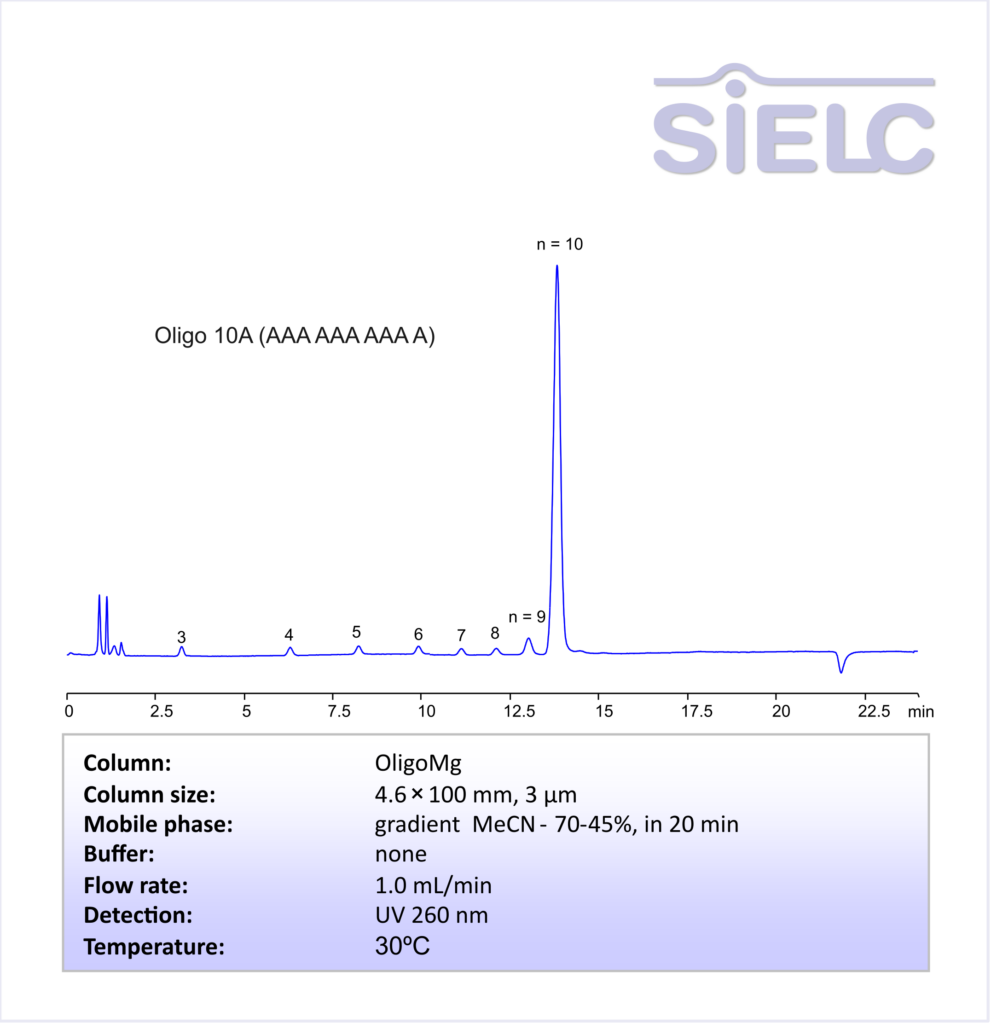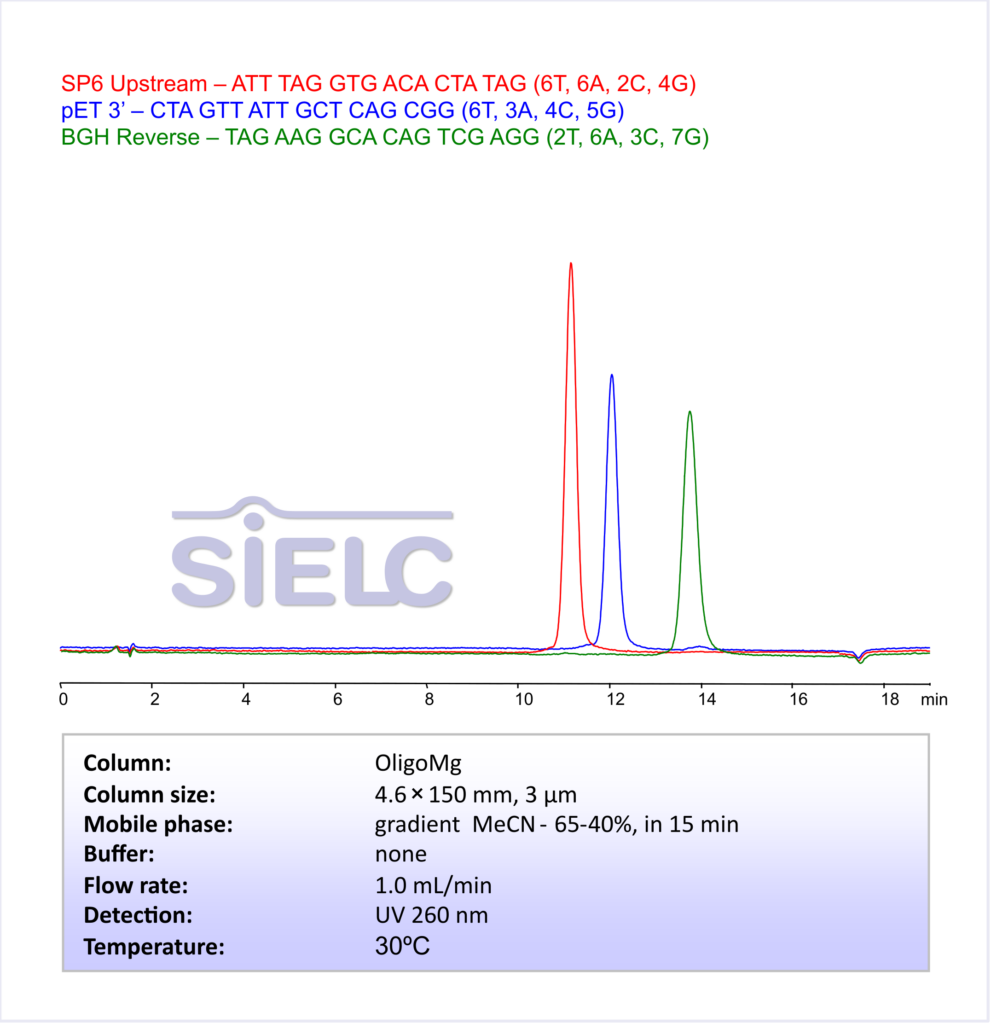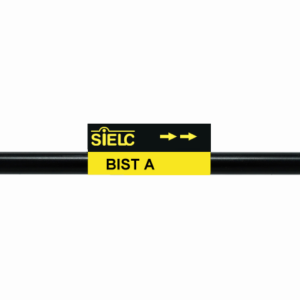
| CAS Number | Oligomers |
|---|---|
| Synonyms |
|
Applications:
HPLC Method for Analysis of Oligonucleotide 5A on Chromni™ Column on Alltesta™
December 1, 2025
HPLC Method for Oligonucleotide 5A on Chromni™ by SIELC Technologies
High Performance Liquid Chromatography (HPLC) Method for Analysis of Oligonucleotide 5A.
Oligonucleotide 5A is a small RNA molecule with a specific adenine sequence. They are primarily used to inhibit viral and cancer cell growth. In RNA synthesis, they are intermediates in enzymatic synthesis of capped RNAs.
Oligonucleotide 5A can be retained and analyzed using the Chromni™ stationary phase column. The analysis utilizes a gradient method with a simple mobile phase consisting of water and acetonitrile (MeCN) with an ammonium formate as a buffer. Detection is performed using UV.
| Column | Chromni™, 4.6 x 150 mm, 5 µm, 100 A, dual ended |
| Mobile Phase | Gradient MeCN – 80-60% |
| Buffer | Ammonium Formate |
| Flow Rate | 1.0 mL/min |
| Detection | UV 275 nm |
| Class of Compounds | Nucleotide Base |
| Analyzing Compounds | Oligonucleotides |
Application Column
Chromni™
Column Diameter: 4.6 mm
Column Length: 150 mm
Particle Size: 5 µm
Pore Size: 100 A
Column options: dual ended

HPLC Method for Analysis of 23-mer Oligonucleotides on OligoMg Column by SIELC Technologies
December 12, 2024
Separation type: Bridge Ion Separation Technology, or BIST™ by SIELC Technologies
HPLC Method for Analysis of 23-mer Oligonucleotides on OligoMg Column by SIELC Technologies
HPLC Method for Analysis of 23-mer Oligonucleotides
23-mer oligonucleotides are short sequences of nucleotides consisting of 23 nucleotide units. These sequences can be composed of any combination of the four standard nucleotides: adenine (A), thymine (T), cytosine (C), and guanine (G).
Research and Studies:
- Molecular Biology: In molecular biology, such oligos can be used as primers for PCR, sequencing, or as probes in hybridization experiments.
- Binding Studies: The poly(A) sequence may be used to study binding interactions with proteins, such as DNA-binding proteins or enzymes.
Medical and Diagnostic Applications:
- As part of diagnostic kits, especially in assays that require hybridization to a complementary sequence.
Educational Purposes:
Demonstrating basic principles of nucleic acid chemistry and genetics.
Nanotechnology:
In DNA nanotechnology, specific sequences of DNA are used to form structures and shapes at the nanoscale. A poly(A) sequence might be part of a larger structure.
Using SIELC’s newly introduced BIST™ method, this oligonucleotide can be retained on a OligoMg column. Using this new and unique analysis method, oligonucleotide can be separated, retained, and detected at 260 nm.
Please read more on oligonucleotides analysis by HPLC in our June 2024 newsletter.
Condition
| Column | OligoMg, 4.6 x 150 mm, 3 µm, 100 A, dual ended |
| Mobile Phase | Gradient MeCN 65-30%, 15 min |
| Buffer | none |
| Flow Rate | 1.0 ml/min |
| Detection | UV 260 nm |
Description
| Class of Compounds | Oligonucleotides |
| Analyzing Compounds | Oligonucleotides |
Application Column
OligoMg
Column Diameter: 4.6 mm
Column Length: 150 mm
Particle Size: 3 µm
Pore Size: 100 A
Column options: dual ended

HPLC Method for Analysis of 10A Oligonucleotides on OligoMg Column by SIELC Technologies
December 12, 2024
Separation type: Bridge Ion Separation Technology, or BIST™ by SIELC Technologies
HPLC Method for Analyzing Oligo 10-mer Oligonucleotides on OligoMg Column by SIELC Technologies
HPLC Method for Analyzing Oligo 10-mer Oligonucleotides
Oligo 10-mer oligonucleotides are short sequences of nucleotides consisting of ten nucleotide units. These oligonucleotides can be composed of any combination of the four standard nucleotides: adenine (A), thymine (T), cytosine (C), and guanine (G).
Research and Studies:
- Molecular Biology: In molecular biology, such oligos can be used as primers for PCR, sequencing, or as probes in hybridization experiments.
- Binding Studies: The poly(A) sequence may be used to study binding interactions with proteins, such as DNA-binding proteins or enzymes.
Medical and Diagnostic Applications:
- As part of diagnostic kits, especially in assays that require hybridization to a complementary sequence.
Educational Purposes:
Demonstrating basic principles of nucleic acid chemistry and genetics.
Nanotechnology:
In DNA nanotechnology, specific sequences of DNA are used to form structures and shapes at the nanoscale. A poly(A) sequence might be part of a larger structure.
Using SIELC’s newly introduced BIST™ method, this oligonucleotide can be retained on a OligoMg column. Using this new and unique analysis method, oligonucleotide can be separated, retained, and detected at 260 nm.
Please read more on oligonucleotides analysis by HPLC in our June 2024 newsletter.
Condition
| Column | OligoMg, 4.6 x 100 mm, 3 µm, 100 A, dual ended |
| Mobile Phase | Gradient MeCN 70-45%, 10 min |
| Buffer | none |
| Flow Rate | 1.0 ml/min |
| Detection | UV 260 nm |
Description
| Class of Compounds | Oligonucleotides |
| Analyzing Compounds | Oligonucleotides |
Application Column
OligoMg
Column Diameter: 4.6 mm
Column Length: 100 mm
Particle Size: 3 µm
Pore Size: 100 A
Column options: dual ended

HPLC Method for Analysis of 17-, 18-, 20-, and 22-mer Oligonucleotides on OligoMg Column by SIELC Technologies
December 12, 2024
Separation type: Bridge Ion Separation Technology, or BIST™ by SIELC Technologies
HPLC Method for Analysis of 17-, 18-, 20-, and 22-mer Oligonucleotides on OligoMg Column by SIELC Technologies
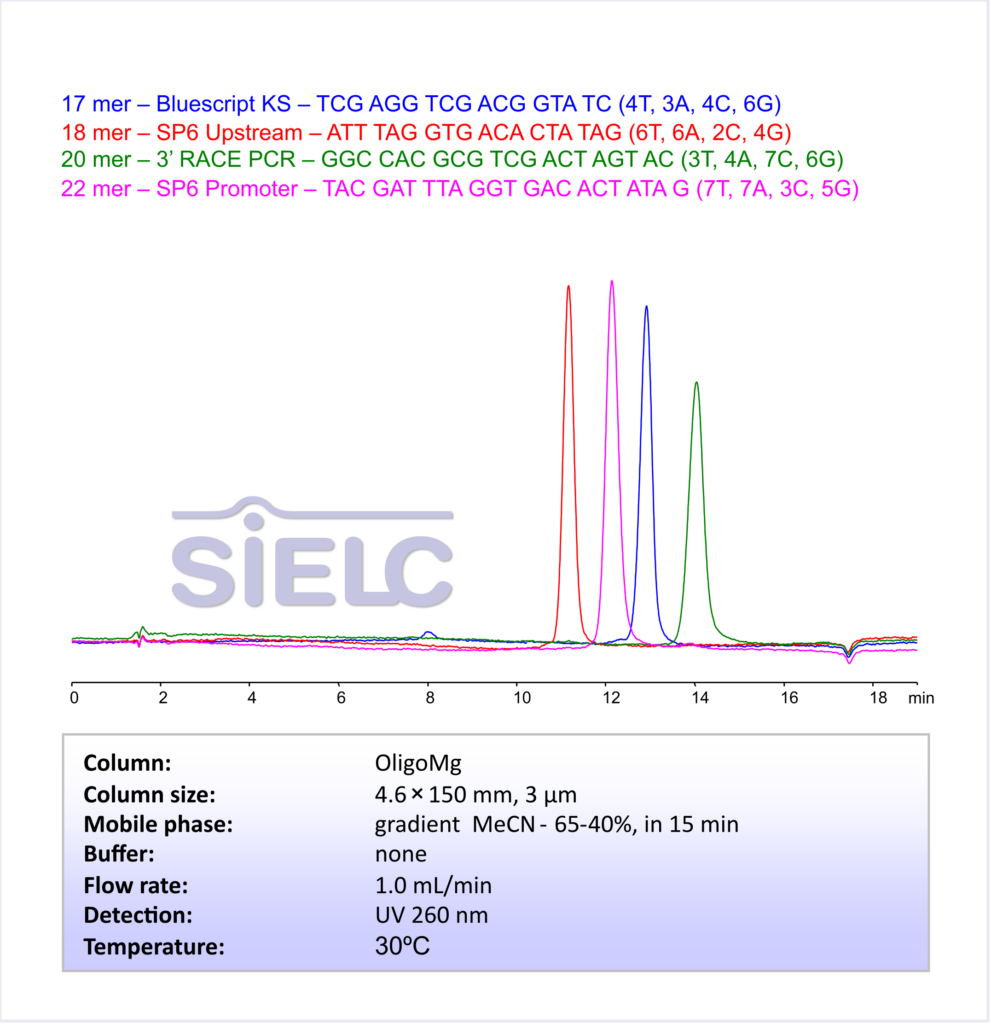
HPLC Method for Analyzing Oligonucleotides
Oligonucleotides are short sequences of nucleotides that serve as essential tools in molecular biology. These oligonucleotides can be composed of any combination of the four standard nucleotides: adenine (A), thymine (T), cytosine (C), and guanine (G).
Research and Studies:
- Molecular Biology: In molecular biology, such oligos can be used as primers for PCR, sequencing, or as probes in hybridization experiments.
- Binding Studies: The poly(A) sequence may be used to study binding interactions with proteins, such as DNA-binding proteins or enzymes.
Medical and Diagnostic Applications:
- As part of diagnostic kits, especially in assays that require hybridization to a complementary sequence.
Educational Purposes:
Demonstrating basic principles of nucleic acid chemistry and genetics.
Nanotechnology:
In DNA nanotechnology, specific sequences of DNA are used to form structures and shapes at the nanoscale. A poly(A) sequence might be part of a larger structure.
Using SIELC’s newly introduced BIST™ method, this oligonucleotide can be retained on a OligoMg column. Using this new and unique analysis method, oligonucleotide can be separated, retained, and detected at 260 nm.
Please read more on oligonucleotides analysis by HPLC in our June 2024 newsletter.
Condition
| Column | OligoMg, 4.6 x 150 mm, 3 µm, 100 A, dual ended |
| Mobile Phase | Gradient MeCN 65-40%, 15 min |
| Buffer | none |
| Flow Rate | 1.0 ml/min |
| Detection | UV 260 nm |
Description
| Class of Compounds | Oligonucleotides |
| Analyzing Compounds | Oligonucleotides |
Application Column
OligoMg
Column Diameter: 4.6 mm
Column Length: 150 mm
Particle Size: 3 µm
Pore Size: 100 A
Column options: dual ended

HPLC Method for Analyzing 18-mer Oligonucleotides on OligoMg Column by SIELC Technologies
October 2, 2024
Separation type: Bridge Ion Separation Technology, or BIST™ by SIELC Technologies
HPLC Method for Analyzing 18-mer Oligonucleotides on OligoMg Column by SIELC Technologies
HPLC Method for Analyzing 18-mer Oligonucleotides
Eighteen-mer oligonucleotides are short sequences of nucleotides consisting of 18 nucleotide units. These oligonucleotides can be composed of any combination of the four standard nucleotides: adenine (A), thymine (T), cytosine (C), and guanine (G).
Research and Studies:
- Molecular Biology: In molecular biology, such oligos can be used as primers for PCR, sequencing, or as probes in hybridization experiments.
- Binding Studies: The poly(A) sequence may be used to study binding interactions with proteins, such as DNA-binding proteins or enzymes.
Medical and Diagnostic Applications:
- As part of diagnostic kits, especially in assays that require hybridization to a complementary sequence.
Educational Purposes:
Demonstrating basic principles of nucleic acid chemistry and genetics.
Nanotechnology:
In DNA nanotechnology, specific sequences of DNA are used to form structures and shapes at the nanoscale. A poly(A) sequence might be part of a larger structure.
Using SIELC’s newly introduced BIST™ method, this oligonucleotide can be retained on a OligoMg column. Using this new and unique analysis method, oligonucleotide can be separated, retained, and detected at 260 nm.
Please read more on oligonucleotides analysis by HPLC in our June 2024 newsletter.
Condition
| Column | OligoMg, 4.6 x 150 mm, 3 µm, 100 A, dual ended |
| Mobile Phase | Gradient MeCN 65-40%, 15 min |
| Buffer | none |
| Flow Rate | 1.0 ml/min |
| Detection | UV 260 nm |
Description
| Class of Compounds | Oligonucleotides |
| Analyzing Compounds | Oligonucleotides |
Application Column
OligoMg
Column Diameter: 4.6 mm
Column Length: 150 mm
Particle Size: 3 µm
Pore Size: 100 A
Column options: dual ended

HPLC Method for Analyzing Oligo 5-mer Oligonucleotides on OligoMg Column by SIELC Technologies
July 2, 2024
Separation type: Bridge Ion Separation Technology, or BIST™ by SIELC Technologies
HPLC Method for Analyzing Oligo 5-mer Oligonucleotides on OligoMg Column by SIELC Technologies
HPLC Method for Analyzing Oligo 5-mer Oligonucleotides
Oligo 5-mer oligonucleotides are short sequences of nucleotides consisting of five nucleotide units. These oligonucleotides can be composed of any combination of the four standard nucleotides: adenine (A), thymine (T), cytosine (C), and guanine (G).
Research and Studies:
- Molecular Biology: In molecular biology, such oligos can be used as primers for PCR, sequencing, or as probes in hybridization experiments.
- Binding Studies: The poly(A) sequence may be used to study binding interactions with proteins, such as DNA-binding proteins or enzymes.
Medical and Diagnostic Applications:
- As part of diagnostic kits, especially in assays that require hybridization to a complementary sequence.
Educational Purposes:
Demonstrating basic principles of nucleic acid chemistry and genetics.
Nanotechnology:
In DNA nanotechnology, specific sequences of DNA are used to form structures and shapes at the nanoscale. A poly(A) sequence might be part of a larger structure.
Using SIELC’s newly introduced BIST™ method, this oligonucleotide can be retained on a OligoMg column. Using this new and unique analysis method, oligonucleotide can be separated, retained, and detected at 260 nm.
Please read more on oligonucleotides analysis by HPLC in our June 2024 newsletter.
Condition
| Column | OligoMg, 4.6 x 100 mm, 3 µm, 100 A, dual ended |
| Mobile Phase | Gradient MeCN 75-55%, 10 min |
| Buffer | none |
| Flow Rate | 1.0 ml/min |
| Detection | UV 260 nm |
Description
| Class of Compounds | Oligonucleotides |
| Analyzing Compounds | Oligonucleotides |
Application Column
OligoMg
Column Diameter: 4.6 mm
Column Length: 100 mm
Particle Size: 3 µm
Pore Size: 100 A
Column options: dual ended

HPLC Method for Analysis of Oligo, 6 mer, Oligonucleotides on OligoMg Column by SIELC Technologies
June 27, 2024
Separation type: Bridge Ion Separation Technology, or BIST™ by SIELC Technologies
HPLC Method for Analysis of DNA Oligo, 6 bases on OligoMg Column by SIELC Technologies
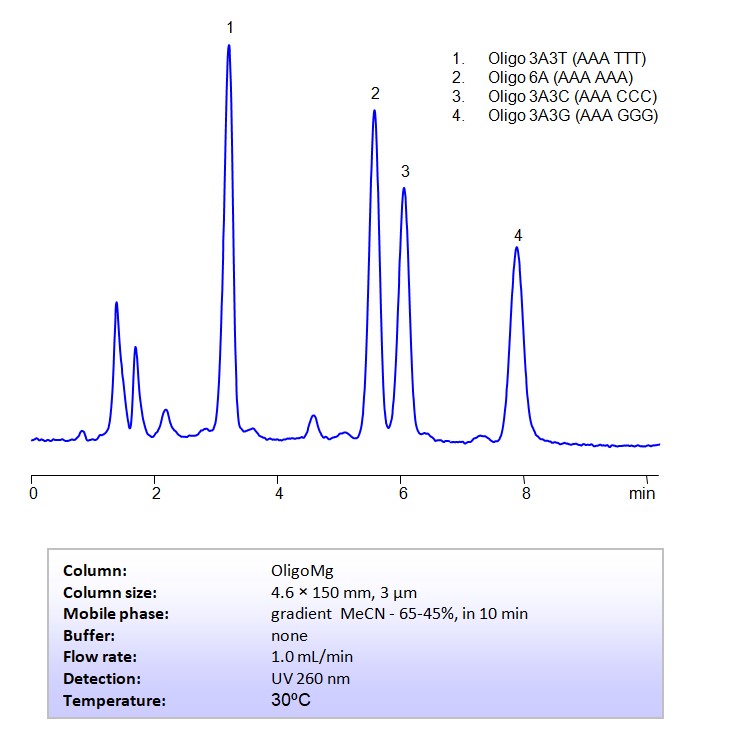
High Performance Liquid Chromatography (HPLC) Method for Analysis of DNA Oligo, 6 bases
The application of a DNA oligo can vary based on the context:
Research and Studies:
- Molecular Biology: In molecular biology, such oligos can be used as primers for PCR, sequencing, or as probes in hybridization experiments.
- Binding Studies: The poly(A) sequence may be used to study binding interactions with proteins, such as DNA-binding proteins or enzymes.
Medical and Diagnostic Applications:
- As part of diagnostic kits, especially in assays that require hybridization to a complementary sequence.
Educational Purposes:
Demonstrating basic principles of nucleic acid chemistry and genetics.
Nanotechnology:
In DNA nanotechnology, specific sequences of DNA are used to form structures and shapes at the nanoscale. A poly(A) sequence might be part of a larger structure.
Using SIELC’s newly introduced BIST™ method, this oligonucleotide can be retained on a OligoMg column. Using this new and unique analysis method, oligonucleotide can be separated, retained, and detected at 260 nm.
Please read more on oligonucleotides analysis by HPLC in our June 2024 newsletter.
Condition
| Column | OligoMg, 4.6 x 150 mm, 3 µm, 100 A, dual ended |
| Mobile Phase | Gradient MeCN 65-45, 10 min |
| Buffer | none |
| Flow Rate | 1.0 ml/min |
| Detection | UV 260 nm |
Description
| Class of Compounds | Oligonucleotides |
| Analyzing Compounds | Oligonucleotides |
Application Column
OligoMg
Column Diameter: 4.6 mm
Column Length: 150 mm
Particle Size: 3 µm
Pore Size: 100 A
Column options: dual ended

HPLC Method for Analysis of Oligo dT, Oligonucleotides on OligoMg Column by SIELC Technologies
June 27, 2024
Separation type: Bridge Ion Separation Technology, or BIST™ by SIELC Technologies
HPLC Method for Analysis of DNA Oligo,T bases on OligoMg Column by SIELC Technologies
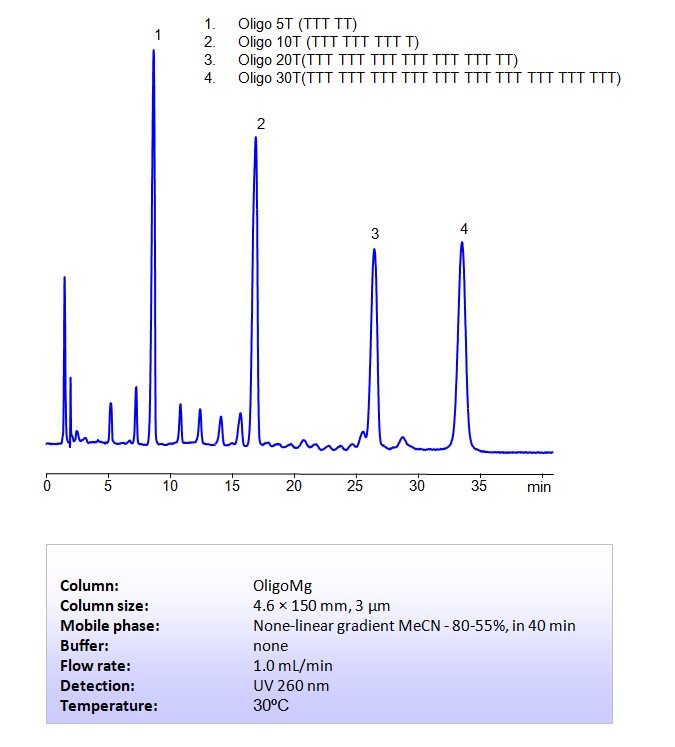
High Performance Liquid Chromatography (HPLC) Method for Analysis of DNA Oligo, T bases
The application of a DNA oligo with can vary based on the context:
Research and Studies:
- Molecular Biology: In molecular biology, such oligos can be used as primers for PCR, sequencing, or as probes in hybridization experiments.
- Binding Studies: The poly(A) sequence may be used to study binding interactions with proteins, such as DNA-binding proteins or enzymes.
Medical and Diagnostic Applications:
- As part of diagnostic kits, especially in assays that require hybridization to a complementary sequence.
Educational Purposes:
Demonstrating basic principles of nucleic acid chemistry and genetics.
Nanotechnology:
In DNA nanotechnology, specific sequences of DNA are used to form structures and shapes at the nanoscale. A poly(A) sequence might be part of a larger structure.
Using SIELC’s newly introduced BIST™ method, this oligonucleotide can be retained on a OligoMg column. Using this new and unique analysis method, oligonucleotide can be separated, retained, and detected at 260 nm.
Please read more on oligonucleotides analysis by HPLC in our June 2024 newsletter.
Condition
| Column | OligoMg, 4.6 x 150 mm, 3 µm, 100 A, dual ended |
| Mobile Phase | None-linear gradient MeCN – 80-55%, in 40 min |
| Buffer | none |
| Flow Rate | 1.0 ml/min |
| Detection | UV 260 nm |
Description
| Class of Compounds | Oligonucleotides |
| Analyzing Compounds | Oligonucleotides |
Application Column
OligoMg
Column Diameter: 4.6 mm
Column Length: 150 mm
Particle Size: 3 µm
Pore Size: 100 A
Column options: dual ended

HPLC Method for Analysis of Oligo dT, 5 mer, Oligonucleotides on OligoMg Column by SIELC Technologies
June 27, 2024
Separation type: Bridge Ion Separation Technology, or BIST™ by SIELC Technologies
HPLC Method for Analysis of DNA Oligo, 5 bases (TT TTT) on OligoMg Column by SIELC Technologies
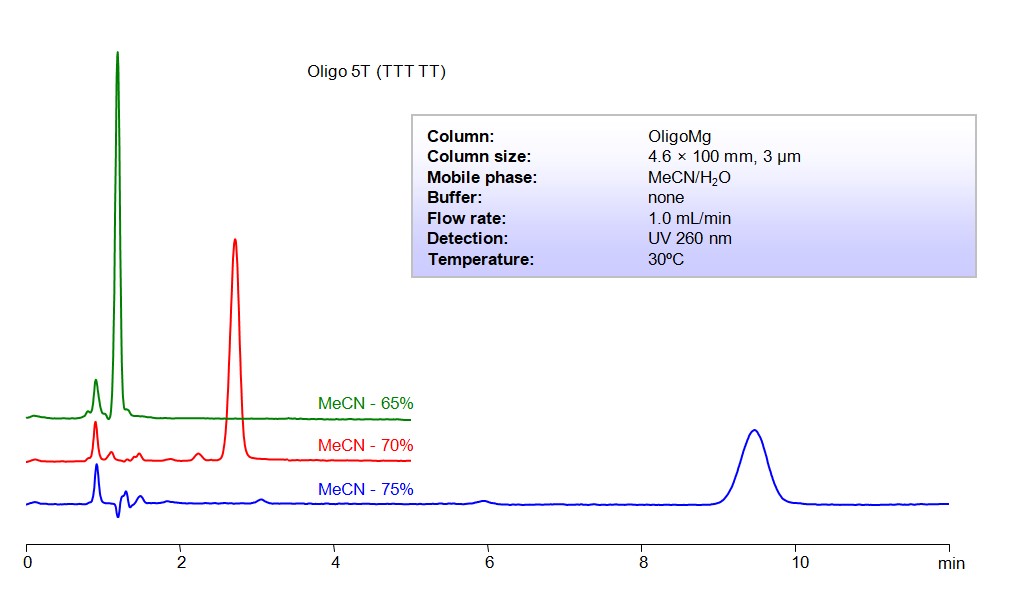
High Performance Liquid Chromatography (HPLC) Method for Analysis of DNA Oligo, 5 bases (TT TTT)
The application of a DNA oligo with a sequence “TT TTT” can vary based on the context:
Research and Studies:
- Molecular Biology: In molecular biology, such oligos can be used as primers for PCR, sequencing, or as probes in hybridization experiments.
- Binding Studies: The poly(A) sequence may be used to study binding interactions with proteins, such as DNA-binding proteins or enzymes.
Medical and Diagnostic Applications:
- As part of diagnostic kits, especially in assays that require hybridization to a complementary sequence.
Educational Purposes:
Demonstrating basic principles of nucleic acid chemistry and genetics.
Nanotechnology:
In DNA nanotechnology, specific sequences of DNA are used to form structures and shapes at the nanoscale. A poly(A) sequence might be part of a larger structure.
Using SIELC’s newly introduced BIST™ method, this oligonucleotide can be retained on a OligoMg column. Using this new and unique analysis method, oligonucleotide can be separated, retained, and detected at 260 nm.
Please read more on oligonucleotides analysis by HPLC in our June 2024 newsletter.
Condition
| Column | OligoMg, 4.6 x 100 mm, 3 µm, 100 A, dual ended |
| Mobile Phase | MeCN |
| Buffer | none |
| Flow Rate | 1.0 ml/min |
| Detection | UV 260 nm |
Description
| Class of Compounds | Oligonucleotides |
| Analyzing Compounds | Oligonucleotides |
Application Column
OligoMg
Column Diameter: 4.6 mm
Column Length: 100 mm
Particle Size: 3 µm
Pore Size: 100 A
Column options: dual ended

HPLC Method for Analysis of Oligonucleotides dA 5 mer on BIST A Column
November 13, 2023
Separation type: Bridge Ion Separation Technology, or BIST™ by SIELC Technologies
HPLC Method for Analysis of DNA Oligo, 5 bases (AAAAA) on BIST A Column by SIELC Technologies
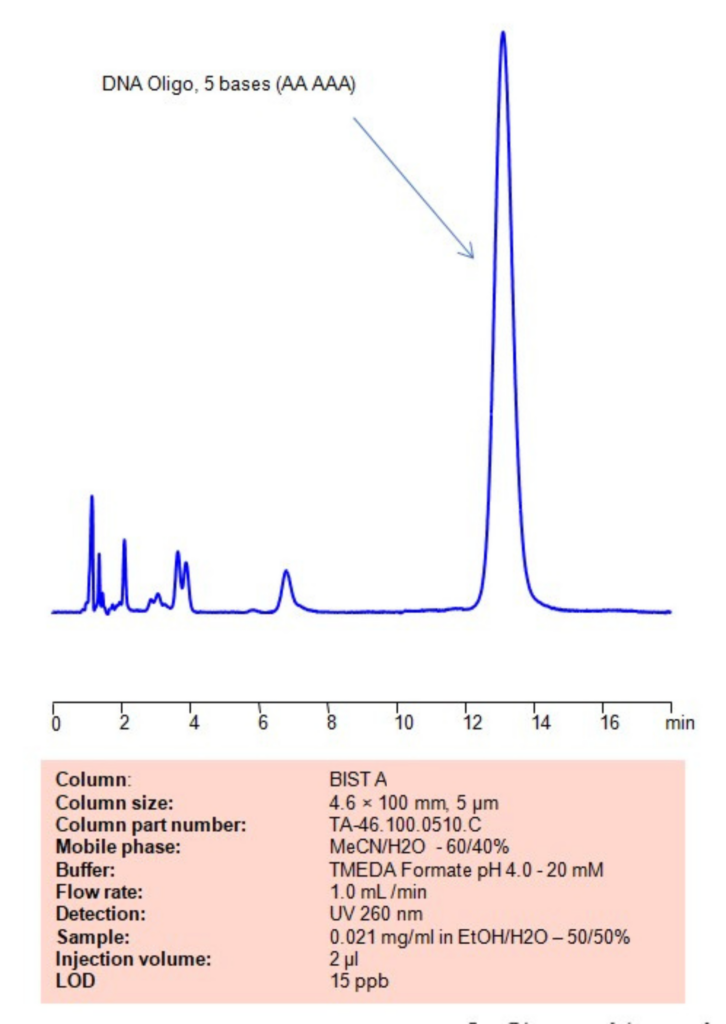
High Performance Liquid Chromatography (HPLC) Method for Analysis of DNA Oligo, 5 bases (AAAAA)
Synthesis of DNA Oligonucleotide (AAAAA)
- Automated Synthesis:
- DNA oligonucleotides, including a sequence like “AAAAA”, are typically synthesized using automated synthesizers based on solid-phase synthesis.
- The process involves the sequential addition of nucleotide residues to the growing chain in a step-wise manner, starting from the 3′-end of the oligo.
- Chemistry:
- The synthesis uses phosphoramidite chemistry, where each nucleotide to be added is in its protected phosphoramidite form.
- The process includes coupling, capping, oxidation, and deprotection steps.
- Purification:
- After synthesis, the oligonucleotide is usually cleaved from the solid support and deprotected.
- It is then purified, commonly by methods like HPLC or PAGE (polyacrylamide gel electrophoresis), depending on the required purity level.
Using DNA Oligo (AAAAA)
The application of a DNA oligo with a sequence “AAAAA” can vary based on the context:
- Research and Studies:
- Molecular Biology: In molecular biology, such oligos can be used as primers for PCR, sequencing, or as probes in hybridization experiments.
- Binding Studies: The poly(A) sequence may be used to study binding interactions with proteins, such as DNA-binding proteins or enzymes.
- Medical and Diagnostic Applications:
- As part of diagnostic kits, especially in assays that require hybridization to a complementary sequence.
- Educational Purposes:
- Demonstrating basic principles of nucleic acid chemistry and genetics.
- Nanotechnology:
- In DNA nanotechnology, specific sequences of DNA are used to form structures and shapes at the nanoscale. A poly(A) sequence might be part of a larger structure.
Using SIELC’s newly introduced BIST™ method, this oligonucleotide can be retained on a negatively-charged, cation-exchange BIST™ A column. There are two keys to this retention method: 1) a multi-charged, positive buffer, such as TMEDA formate, which acts as a bridge, linking the negatively charged dye to the negatively-charged column surface and 2) a mobile phase consisting mostly of organic solvent (such as MeCN) to minimize the formation of a solvation layer around the charged analytes. Using this new and unique analysis method, oligonucleotide can be separated, retained, and detected at 260 nm.
Condition
| Column | BIST A, 4.6 x 100 mm, 5 µm, 100 A, surface coated |
| Mobile Phase | MeCN – 60% |
| Buffer | TMEDA Formate pH 4.0 – 20 mM |
| Flow Rate | 1.0 ml/min |
| Detection | UV 260 nm |
| Sample | 0.021 mg/ml in EtOH/H2O – 50/50% |
| Injection volume | 1 µl |
| LOD* | 15 ppb |
Description
| Class of Compounds | Oligonucleotides |
| Analyzing Compounds | Oligonucleotides |
Application Column
BIST A
Column Diameter: 4.6 mm
Column Length: 100 mm
Particle Size: 5 µm
Pore Size: 100 A
Column options: surface coated

HPLC Method for Analysis of Oligonucleotides dt 5 mer on BIST A Column
November 13, 2023
Separation type: Bridge Ion Separation Technology, or BIST™ by SIELC Technologies
HPLC Method for Analysis of DNA Oligo, 5 bases (TT TTT) on BIST A Column by SIELC Technologies
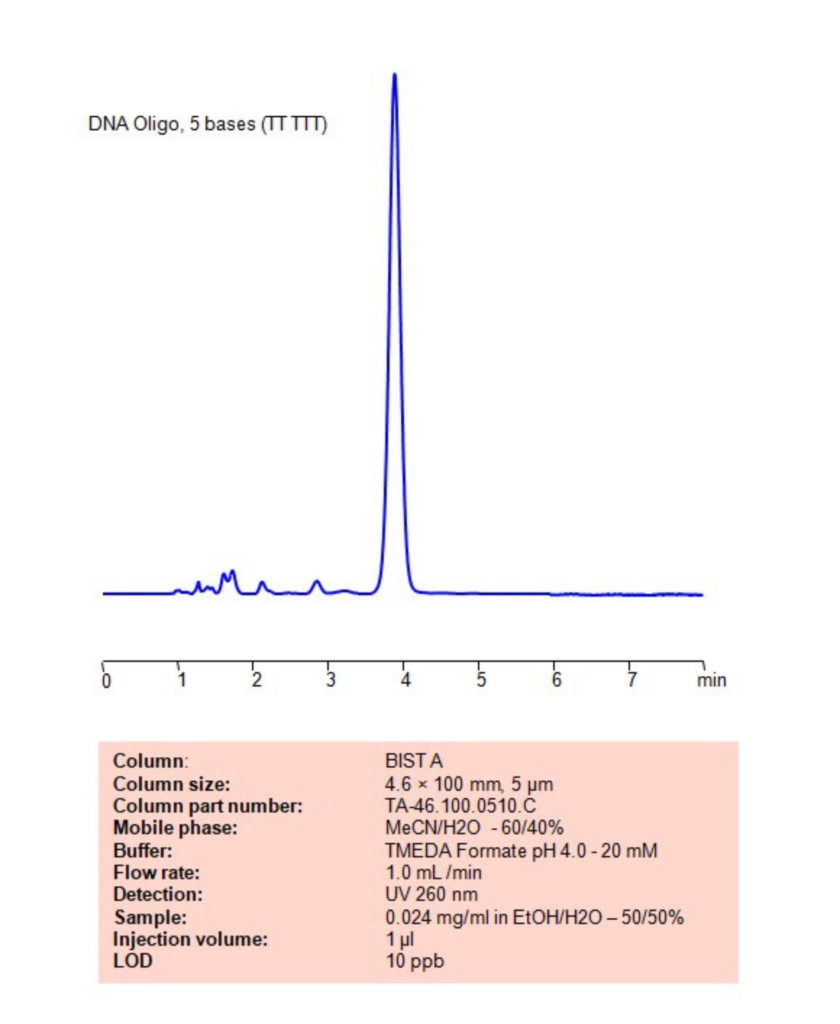
High Performance Liquid Chromatography (HPLC) Method for Analysis of DNA Oligo, 5 bases (TT TTT)
DNA oligos, short for oligonucleotides, are small fragments of DNA that are often synthesized for various scientific and medical applications. A DNA oligo with a sequence of 5 thymine bases, denoted as “TTTTT,” has some specific properties and uses:
Properties:
Composition: This oligo is composed of five thymine (T) nucleotides, which are pyrimidine bases.
Stability: Thymine-rich oligos can have different stability characteristics compared to those rich in other nucleotides. The stability of DNA strands is influenced by base stacking interactions and hydrogen bonding.
Hybridization Potential: The ability of this oligo to hybridize (bind) with other DNA or RNA sequences is limited due to its homopolymer nature. It would preferentially bind to sequences rich in adenine (A).
Uses:
- Molecular Probes: It can be used as a probe in molecular biology experiments to bind to complementary sequences.
- Polymerase Chain Reaction (PCR): These oligos can serve as primers in PCR, but their effectiveness is limited due to the repetitive nature of the sequence.
- Research: In research, such oligos can be used to study the properties of DNA, DNA-protein interactions, and the mechanisms of enzymes that interact with DNA.
- Control Experiments: Due to its simplicity, it can be used in control experiments to compare with more complex oligonucleotides.
Limitations:
- Non-specific Binding: The homopolymer sequence may lead to non-specific binding in certain applications.
- Lower Melting Temperature: Homopolymers like “TTTTT” tend to have lower melting temperatures, which could affect their use in temperature-sensitive applications.
DNA oligo with the sequence “TTTTT” has unique properties related to its homopolymer nature and finds specific uses in molecular biology, although it also has some limitations due to its repetitive sequence.
Using SIELC’s newly introduced BIST™ method, this oligonucleotide can be retained on a negatively-charged, cation-exchange BIST™ A column. There are two keys to this retention method: 1) a multi-charged, positive buffer, such as TMEDA formate, which acts as a bridge, linking the negatively charged dye to the negatively-charged column surface and 2) a mobile phase consisting mostly of organic solvent (such as MeCN) to minimize the formation of a solvation layer around the charged analytes. Using this new and unique analysis method, oligonucleotide can be separated, retained, and detected at 260 nm.
Please read more on oligonucleotides analysis by HPLC in our April’s 2023 newsletter.
Condition
| Column | BIST A, 4.6 x 100 mm, 5 µm, 100 A, surface coated |
| Mobile Phase | MeCN – 60% |
| Buffer | TMEDA Formate pH 4.0 – 20 mM |
| Flow Rate | 1.0 ml/min |
| Detection | UV 260 nm |
| Sample | 0.024 mg/ml in EtOH/H2O – 50/50% |
| Injection volume | 1 µl |
| LOD* | 10 ppb |
Description
| Class of Compounds | Oligonucleotides |
| Analyzing Compounds | Oligonucleotides |
Application Column
BIST A
Column Diameter: 4.6 mm
Column Length: 100 mm
Particle Size: 5 µm
Pore Size: 100 A
Column options: surface coated

HPLC Method for Analysis of Oligonucleotides dt 20mer with 5′ phosphate on BIST A Column
April 26, 2023
Separation type: Bridge Ion Separation Technology, or BIST™ by SIELC Technologies
HPLC Method for Analysis of Oligonucleotides on BIST A Column by SIELC Technologies
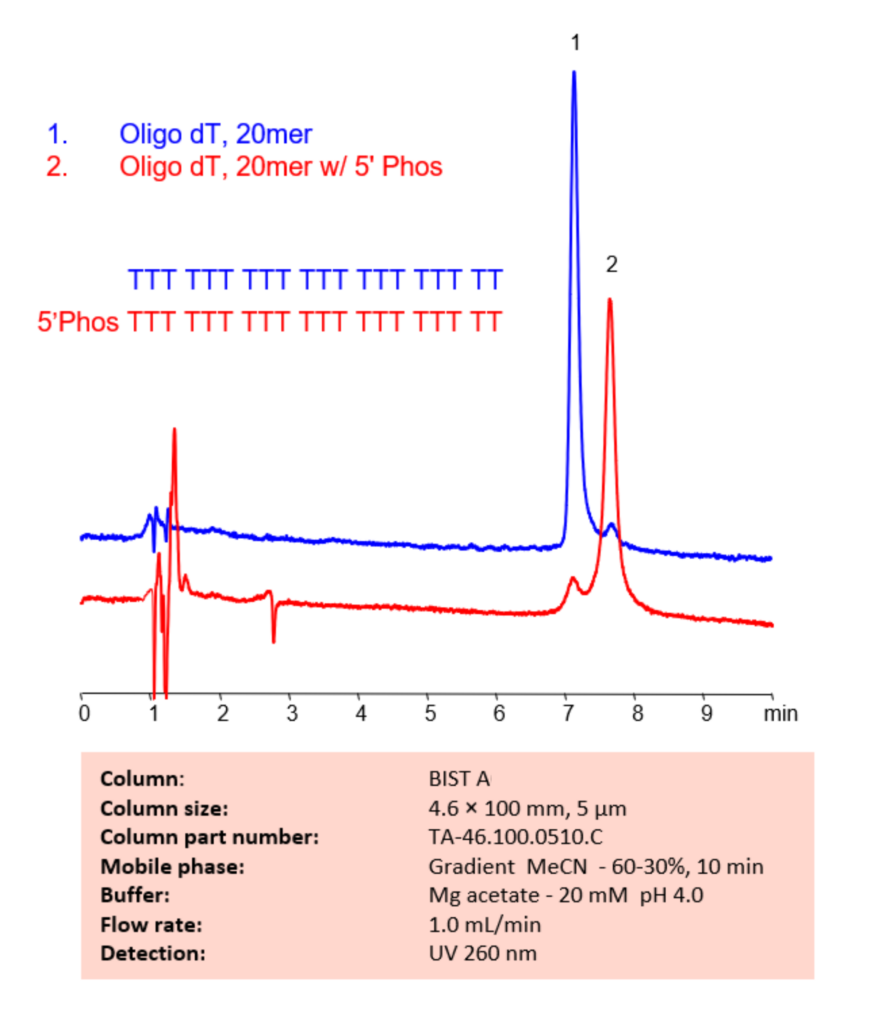
High Performance Liquid Chromatography (HPLC) Method for Analysis of Oligonucleotides
A 20 mer oligonucleotide is a short DNA molecule that is 20 nucleotides in length. Oligonucleotides of this length are commonly used in molecular biology research for a variety of applications, including PCR, DNA sequencing, gene expression analysis, and gene editing.
This is an example of an oligonucleotide sequence with a 5′ phosphate group. The sequence is a single-stranded DNA molecule that consists of a stretch of thymine (T) nucleotides, and its length is 20 nucleotides. The “5’Phos” notation indicates the presence of a phosphate group attached to the 5′ end of the oligonucleotide.
The sequence of the oligonucleotide is:
5′ Phos TTT TTT TTT TTT TTT TTT TT
The 5′ phosphate group is often added to oligonucleotides used in various molecular biology techniques, such as DNA sequencing or cloning, to improve their stability and to facilitate their ligation to other DNA molecules. The presence of the phosphate group can also affect the efficiency of enzymatic reactions, such as ligation or phosphorylation.
Using SIELC’s newly introduced BIST™ method, this oligonucleotide can be retained on a negatively-charged, cation-exchange BIST™ A column. There are two keys to this retention method: 1) a multi-charged, positive buffer, such as TMEDA formate, which acts as a bridge, linking the negatively charged dye to the negatively-charged column surface and 2) a mobile phase consisting mostly of organic solvent (such as MeCN) to minimize the formation of a solvation layer around the charged analytes. Using this new and unique analysis method, oligonucleotide can be separated, retained, and detected at 260 nm.
Please read more on oligonucleotides analysis by HPLC in our April’s 2023 newsletter.
Condition
| Column | BIST A, 4.6 x 100 mm, 5 µm, 100 A, surface coated |
| Mobile Phase | Gradient MeCN – 60-30%, 10 min |
| Buffer | Mg acetate pH 4.0 – 20 mM |
| Flow Rate | 1.0 ml/min |
| Detection | UV 260 nm |
Description
| Class of Compounds | Oligonucleotides |
| Analyzing Compounds | Oligonucleotides |
Application Column
BIST A
Column Diameter: 4.6 mm
Column Length: 100 mm
Particle Size: 5 µm
Pore Size: 100 A
Column options: surface coated

HPLC Method for Analysis of Oligonucleotides 37 mer on BIST A Column
April 26, 2023
Separation type: Bridge Ion Separation Technology, or BIST™ by SIELC Technologies
HPLC Method for Analysis of Oligonucleotides on BIST A Column by SIELC Technologies
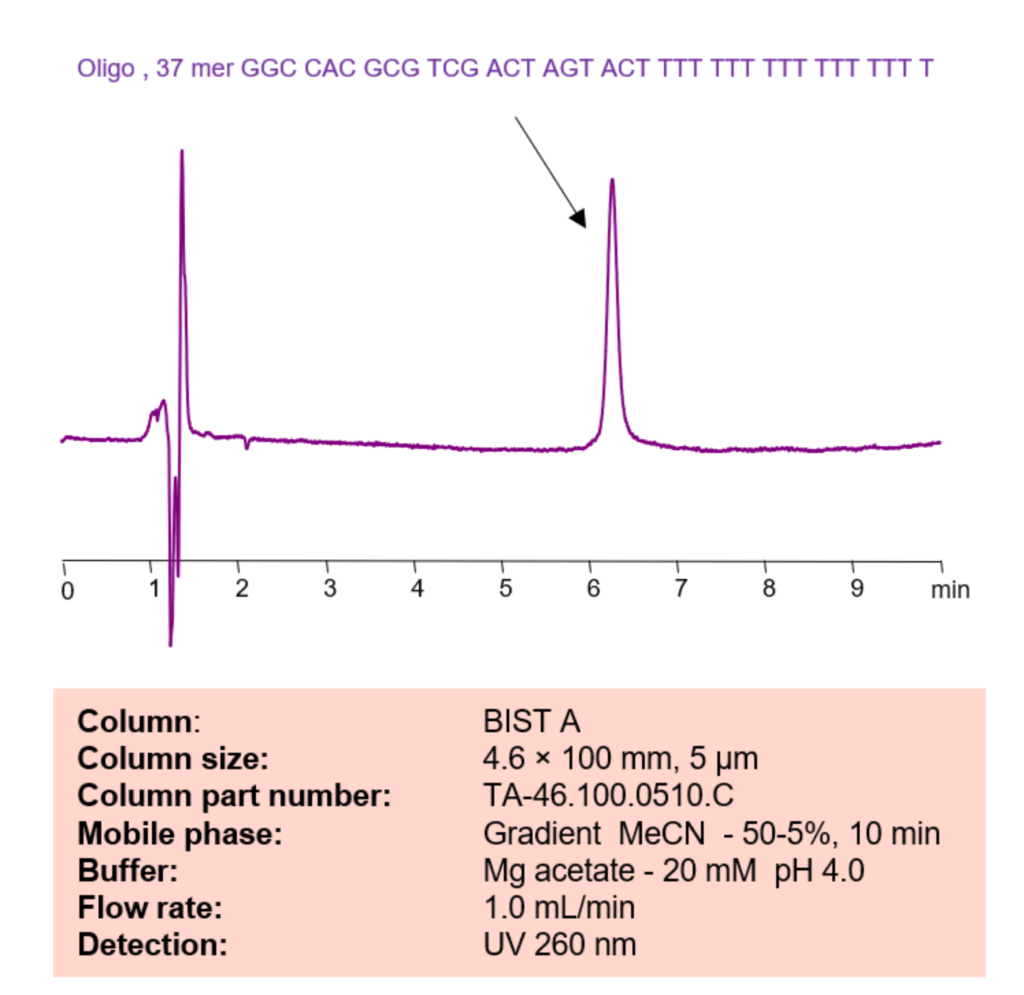
High Performance Liquid Chromatography (HPLC) Method for Analysis of Oligonucleotides
This is a single-stranded DNA molecule that is 37 nucleotides long, and its sequence is as follows:
GGC CAC GCG TCG ACT AGT ACT TTT TTT TTT TTT TTT TTT T
The sequence contains the nucleotides G, C, A, and T, which represent the four different bases in DNA. The sequence also contains a stretch of thymine (T) nucleotides at the end, which serves as a poly-T tail. This tail is often added to oligonucleotides used in PCR and other molecular biology techniques to increase their binding affinity to the target DNA sequence.
The sequence also contains a specific sequence that can be used for hybridization or amplification purposes. The sequence GGC CAC GCG TCG ACT AGT ACT is known as the “primer” sequence, and it can be used to specifically bind to a complementary DNA sequence in PCR or other molecular biology techniques.
Overall, the sequence shown is an example of a synthetic oligonucleotide that can be used in various molecular biology applications.
Using SIELC’s newly introduced BIST™ method, this oligonucleotide can be retained on a negatively-charged, cation-exchange BIST™ A column. There are two keys to this retention method: 1) a multi-charged, positive buffer, such as TMEDA formate, which acts as a bridge, linking the negatively charged dye to the negatively-charged column surface and 2) a mobile phase consisting mostly of organic solvent (such as MeCN) to minimize the formation of a solvation layer around the charged analytes. Using this new and unique analysis method, oligonucleotide can be separated, retained, and detected at 260 nm.
Please read more on oligonucleotides analysis by HPLC in our April’s 2023 newsletter.
Condition
| Column | BIST A, 4.6 x 100 mm, 5 µm, 100 A, surface coated |
| Mobile Phase | Gradient MeCN – 50-5%, 10 min |
| Buffer | Mg acetate pH 4.0 – 20 mM |
| Flow Rate | 1.0 ml/min |
| Detection | UV 260 nm |
Description
| Class of Compounds | Oligonucleotides |
| Analyzing Compounds | Oligonucleotides |
Application Column
BIST A
Column Diameter: 4.6 mm
Column Length: 100 mm
Particle Size: 5 µm
Pore Size: 100 A
Column options: surface coated

HPLC Method for Analysis of Mixture of dT Oligonucleotides on BIST A Column
April 25, 2023
Separation type: Bridge Ion Separation Technology, or BIST™ by SIELC Technologies
HPLC Method for Analysis of Oligonucleotides on BIST A Column by SIELC Technologies
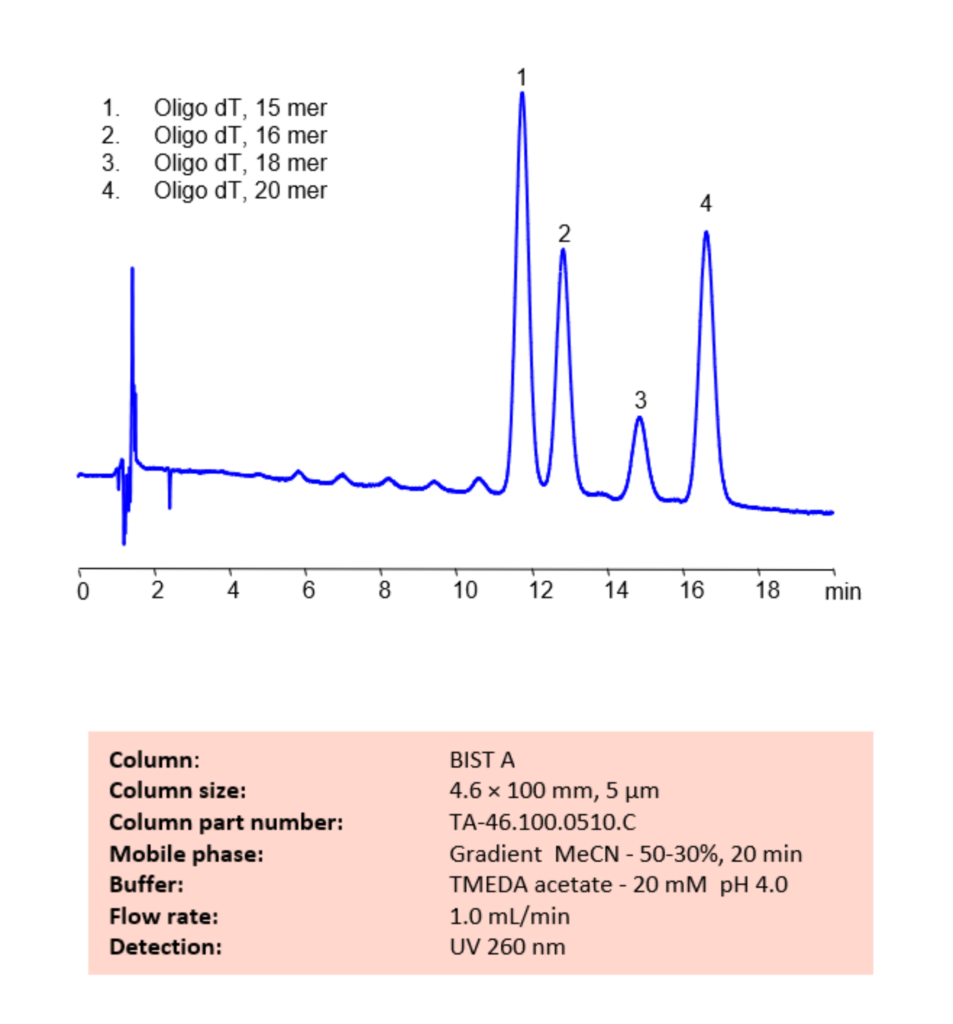
High Performance Liquid Chromatography (HPLC) Method for Analysis of Oligonucleotides
Oligonucleotides dT, also known as deoxythymidine oligonucleotides, are short, single-stranded DNA molecules composed of repeating units of deoxythymidine. They are commonly used in molecular biology techniques such as PCR (polymerase chain reaction), cDNA synthesis, and DNA sequencing.
In PCR, oligonucleotides dT are often used as primers to initiate DNA synthesis. They bind to the complementary strand of DNA at the 3′ end and serve as the starting point for DNA polymerase to extend the new strand.
In cDNA synthesis, oligonucleotides dT are used to prime reverse transcription of mRNA into cDNA. They bind to the poly(A) tail of mRNA, which is composed of multiple consecutive adenosines, and initiate the reverse transcription process.
Overall, oligonucleotides dT are a useful tool in molecular biology for a variety of applications where specific DNA or cDNA sequences need to be targeted and amplified.
Using SIELC’s newly introduced BIST™ method, this oligonucleotide can be retained on a negatively-charged, cation-exchange BIST™ A column. There are two keys to this retention method: 1) a multi-charged, positive buffer, such as TMEDA formate, which acts as a bridge, linking the negatively charged dye to the negatively-charged column surface and 2) a mobile phase consisting mostly of organic solvent (such as MeCN) to minimize the formation of a solvation layer around the charged analytes. Using this new and unique analysis method, oligonucleotide can be separated, retained, and detected at 260 nm.
Please read more on oligonucleotides analysis by HPLC in our April’s 2023 newsletter.
Condition
| Column | BIST A, 4.6 x 100 mm, 5 µm, 100 A, surface coated |
| Mobile Phase | Gradient MeCN – 50-30%, 20 min |
| Buffer | TMEDA acetate pH 4.0 – 20 mM |
| Flow Rate | 1.0 ml/min |
| Detection | UV 260 nm |
Description
| Class of Compounds | Oligonucleotides |
| Analyzing Compounds | Oligonucleotides |
Application Column
BIST A
Column Diameter: 4.6 mm
Column Length: 100 mm
Particle Size: 5 µm
Pore Size: 100 A
Column options: surface coated

HPLC Method for Analysis of Oligonucleotides 18 mer on BIST A Column with Mg Acetate as a Buffer
April 24, 2023
Separation type: Bridge Ion Separation Technology, or BIST™ by SIELC Technologies
HPLC Method for Analysis of Oligonucleotides on BIST A Column by SIELC Technologies
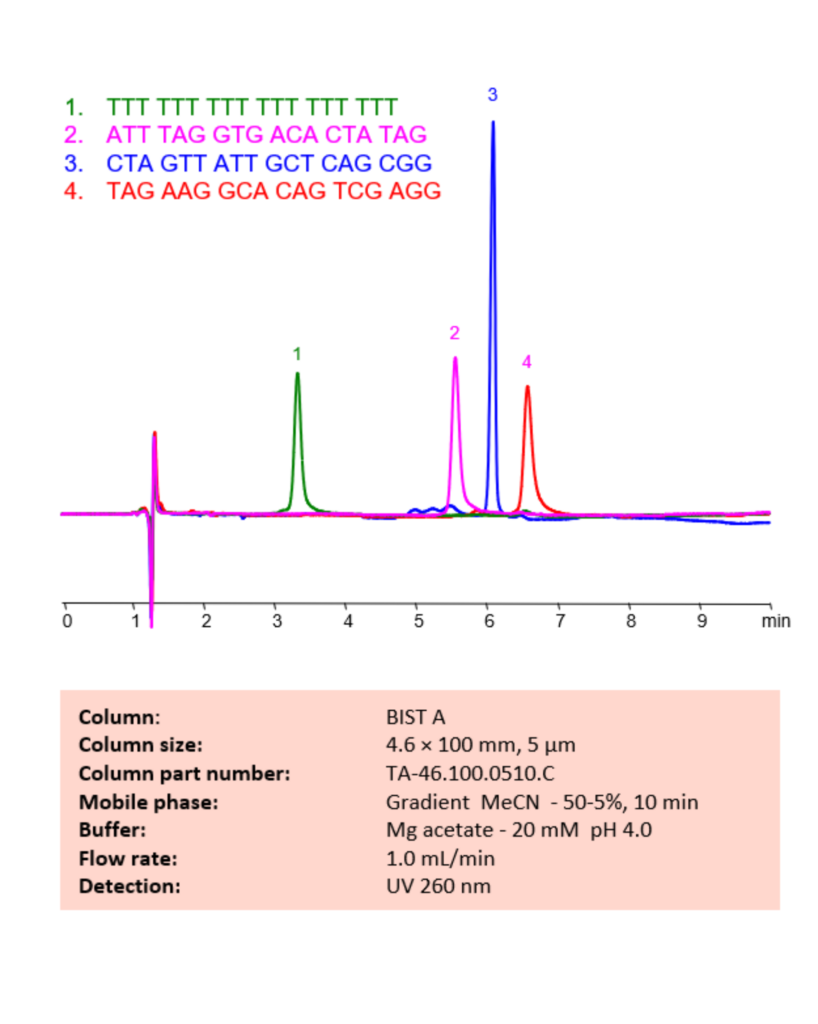
High Performance Liquid Chromatography (HPLC) Method for Analysis of Oligonucleotides
An 18-mer oligonucleotide is a short DNA molecule that is 18 nucleotides in length. Oligonucleotides of this length are commonly used in molecular biology research for a variety of applications, including PCR, DNA sequencing, gene expression analysis, and gene editing.
One common use of 18-mer oligonucleotides is as primers in PCR. PCR amplifies specific DNA sequences by using oligonucleotide primers that are complementary to the target sequence. The primers hybridize to the template DNA and serve as starting points for DNA polymerase to extend the DNA sequence in the direction of the primer.
In addition to PCR, 18-mer oligonucleotides can also be used as probes for hybridization-based assays such as fluorescence in situ hybridization (FISH) or Southern blotting. These assays use oligonucleotide probes that are complementary to a specific DNA sequence of interest to identify the presence or absence of the target sequence.
Furthermore, 18-mer oligonucleotides are often used in gene editing techniques, such as CRISPR-Cas9. In this technique, an 18-mer oligonucleotide serves as a guide RNA (gRNA) to direct the Cas9 nuclease to the target DNA sequence, where it can make a precise cut and initiate DNA repair processes.
Overall, 18-mer oligonucleotides are versatile tools in molecular biology research that allow scientists to target specific DNA sequences for amplification, detection, and modification.
Using SIELC’s newly introduced BIST™ method, this oligonucleotide can be retained on a negatively-charged, cation-exchange BIST™ A column. There are two keys to this retention method: 1) a multi-charged, positive buffer, such as Mg acetate, which acts as a bridge, linking the negatively charged dye to the negatively-charged column surface and 2) a mobile phase consisting mostly of organic solvent (such as MeCN) to minimize the formation of a solvation layer around the charged analytes. Using this new and unique analysis method, oligonucleotide can be separated, retained, and detected at 260 nm.
Please read more on oligonucleotides analysis by HPLC in our April’s 2023 newsletter.
Condition
| Column | BIST A, 4.6 x 100 mm, 5 µm, 100 A, surface coated |
| Mobile Phase | MeCN |
| Buffer | Mg acetate pH 4.0 – 20 mM |
| Flow Rate | 1.0 ml/min |
| Detection | UV 260 nm |
Description
| Class of Compounds | Oligonucleotides |
| Analyzing Compounds | Oligonucleotides |
Application Column
BIST A
Column Diameter: 4.6 mm
Column Length: 100 mm
Particle Size: 5 µm
Pore Size: 100 A
Column options: surface coated

HPLC Method for Analysis of Oligonucleotides 18 mer on BIST A Column
April 24, 2023
Separation type: Bridge Ion Separation Technology, or BIST™ by SIELC Technologies
HPLC Method for Analysis of Oligonucleotides on BIST A Column by SIELC Technologies
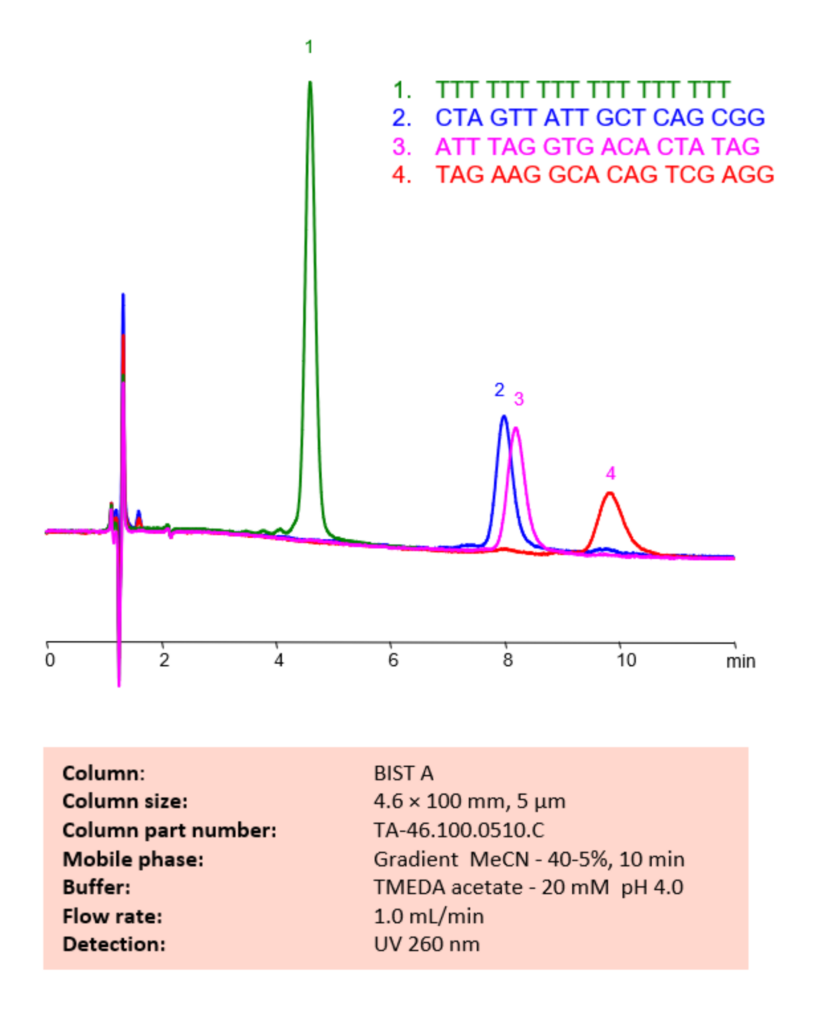
High Performance Liquid Chromatography (HPLC) Method for Analysis of Oligonucleotides
An 18-mer oligonucleotide is a short DNA molecule that is 18 nucleotides in length. Oligonucleotides of this length are commonly used in molecular biology research for a variety of applications, including PCR, DNA sequencing, gene expression analysis, and gene editing.
One common use of 18-mer oligonucleotides is as primers in PCR. PCR amplifies specific DNA sequences by using oligonucleotide primers that are complementary to the target sequence. The primers hybridize to the template DNA and serve as starting points for DNA polymerase to extend the DNA sequence in the direction of the primer.
In addition to PCR, 18-mer oligonucleotides can also be used as probes for hybridization-based assays such as fluorescence in situ hybridization (FISH) or Southern blotting. These assays use oligonucleotide probes that are complementary to a specific DNA sequence of interest to identify the presence or absence of the target sequence.
Furthermore, 18-mer oligonucleotides are often used in gene editing techniques, such as CRISPR-Cas9. In this technique, an 18-mer oligonucleotide serves as a guide RNA (gRNA) to direct the Cas9 nuclease to the target DNA sequence, where it can make a precise cut and initiate DNA repair processes.
Overall, 18-mer oligonucleotides are versatile tools in molecular biology research that allow scientists to target specific DNA sequences for amplification, detection, and modification.
Using SIELC’s newly introduced BIST™ method, this oligonucleotide can be retained on a negatively-charged, cation-exchange BIST™ A column. There are two keys to this retention method: 1) a multi-charged, positive buffer, such as TMEDA acetate, which acts as a bridge, linking the negatively charged dye to the negatively-charged column surface and 2) a mobile phase consisting mostly of organic solvent (such as MeCN) to minimize the formation of a solvation layer around the charged analytes. Using this new and unique analysis method, oligonucleotide can be separated, retained, and detected at 260 nm.
Please read more on oligonucleotides analysis by HPLC in our April’s 2023 newsletter.
Condition
| Column | BIST A, 4.6 x 100 mm, 5 µm, 100 A, surface coated |
| Mobile Phase | MeCN |
| Buffer | TMEDA acetate pH 4.0 – 20 mM |
| Flow Rate | 1.0 ml/min |
| Detection | UV 260 nm |
Description
| Class of Compounds | Oligonucleotides |
| Analyzing Compounds | Oligonucleotides |
Application Column
BIST A
Column Diameter: 4.6 mm
Column Length: 100 mm
Particle Size: 5 µm
Pore Size: 100 A
Column options: surface coated

HPLC Method for Analysis of Oligonucleotides octomer on BIST A Column
April 24, 2023
Separation type: Bridge Ion Separation Technology, or BIST™ by SIELC Technologies
HPLC Method for Analysis of Oligonucleotides on BIST A Column by SIELC Technologies
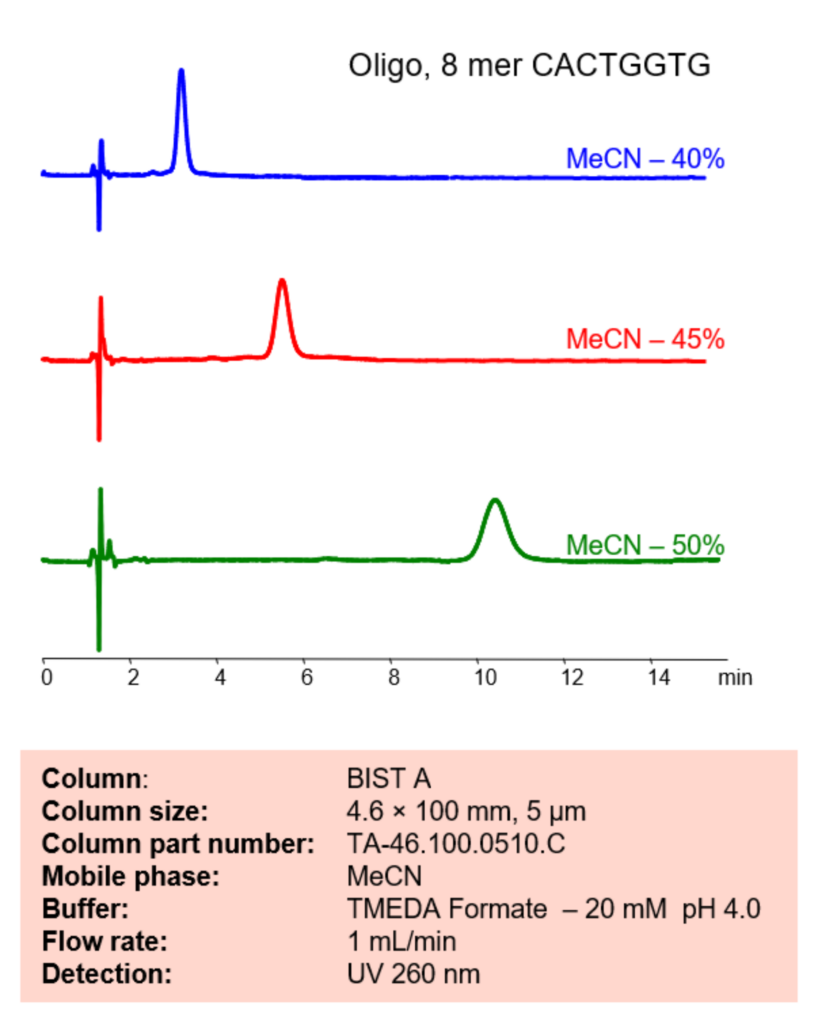
High Performance Liquid Chromatography (HPLC) Method for Analysis of Oligonucleotides
An oligonucleotide octomer is a short DNA molecule that consists of eight nucleotides. These types of oligonucleotides are commonly used in molecular biology research for various applications, such as PCR, DNA sequencing, gene expression analysis, and gene editing.
Octomer oligonucleotides can be designed to be complementary to a specific DNA sequence of interest and can serve as primers or probes for amplification, detection, or modification of that sequence. For example, in PCR, two octomer oligonucleotides can be used as forward and reverse primers to amplify a target DNA fragment between them.
Octomer oligonucleotides can also be used as building blocks for the synthesis of longer oligonucleotides or genes through enzymatic or chemical methods. Additionally, they can be used as substrates for various DNA-modifying enzymes, such as ligases, kinases, or nucleases.
Overall, octomer oligonucleotides are valuable tools in molecular biology research, allowing scientists to study DNA sequences and manipulate them for various applications. The properties and potential applications of an octomer oligonucleotide will depend on its specific sequence and the experimental conditions used.
Using SIELC’s newly introduced BIST™ method, this oligonucleotide can be retained on a negatively-charged, cation-exchange BIST™ A column. There are two keys to this retention method: 1) a multi-charged, positive buffer, such as TMEDA formate, which acts as a bridge, linking the negatively charged dye to the negatively-charged column surface and 2) a mobile phase consisting mostly of organic solvent (such as MeCN) to minimize the formation of a solvation layer around the charged analytes. Using this new and unique analysis method, oligonucleotide can be separated, retained, and detected at 260 nm.
Please read more on oligonucleotides analysis by HPLC in our April’s 2023 newsletter.
The sequence consists of the following nucleotides:
C – cytosine A – adenine C – cytosine T – thymine G – guanine G – guanine T – thymine G – guanine
Condition
| Column | BIST A, 4.6 x 100 mm, 5 µm, 100 A, surface coated |
| Mobile Phase | MeCN |
| Buffer | TMEDA formate pH 4.0 – 20 mM |
| Flow Rate | 1.0 ml/min |
| Detection | UV 260 nm |
Description
| Class of Compounds | Oligonucleotides |
| Analyzing Compounds | Oligonucleotides |
Application Column
BIST A
Column Diameter: 4.6 mm
Column Length: 100 mm
Particle Size: 5 µm
Pore Size: 100 A
Column options: surface coated

HPLC Method for Analysis of Oligonucleotides 20 mer on BIST A Column
April 21, 2023
Separation type: Bridge Ion Separation Technology, or BIST™ by SIELC Technologies
HPLC Method for Analysis of Oligonucleotides on BIST A Column by SIELC Technologies
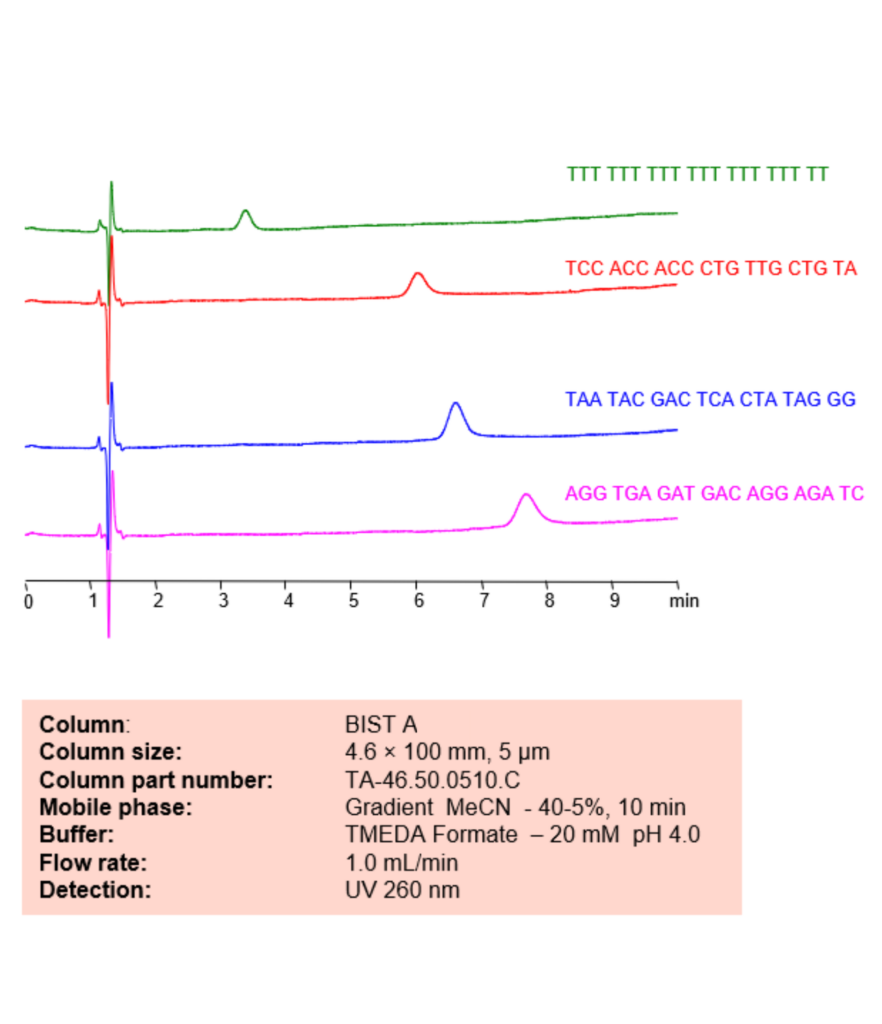
High Performance Liquid Chromatography (HPLC) Method for Analysis of Oligonucleotides
A 20 mer oligonucleotide is a short DNA molecule that is 20 nucleotides in length. Oligonucleotides of this length are commonly used in molecular biology research for a variety of applications, including PCR, DNA sequencing, gene expression analysis, and gene editing.
One common use of 20 mer oligonucleotides is as primers in PCR. PCR amplifies specific DNA sequences by using oligonucleotide primers that are complementary to the target sequence. The primers hybridize to the template DNA and serve as starting points for DNA polymerase to extend the DNA sequence in the direction of the primer.
Furthermore, 20 mer oligonucleotides are often used in gene editing techniques, such as CRISPR-Cas9. In this technique, a 20 mer oligonucleotide serves as a guide RNA (gRNA) to direct the Cas9 nuclease to the target DNA sequence, where it can make a precise cut and initiate DNA repair processes.
Overall, 20 mer oligonucleotides are versatile tools in molecular biology research that allow scientists to target specific DNA sequences for amplification, detection, and modification.
Using SIELC’s newly introduced BIST™ method, this oligonucleotide can be retained on a negatively-charged, cation-exchange BIST™ A column. There are two keys to this retention method: 1) a multi-charged, positive buffer, such as TMEDA formate, which acts as a bridge, linking the negatively charged dye to the negatively-charged column surface and 2) a mobile phase consisting mostly of organic solvent (such as MeCN) to minimize the formation of a solvation layer around the charged analytes. Using this new and unique analysis method, oligonucleotide can be separated, retained, and detected at 260 nm.
Condition
| Column | BIST A, 4.6 x 100 mm, 5 µm, 100 A, surface coated |
| Mobile Phase | Gradient MeCN – 40-5%, 10 min |
| Buffer | TMEDA formate pH 4.0 – 20 mM |
| Flow Rate | 1.0 ml/min |
| Detection | UV 260 nm |
Description
| Class of Compounds | Oligonucleotides |
| Analyzing Compounds | Oligonucleotides |
Application Column
BIST A
Column Diameter: 4.6 mm
Column Length: 100 mm
Particle Size: 5 µm
Pore Size: 100 A
Column options: surface coated

HPLC Method for Analysis of Oligo dT, 16 mer on BIST A Column
April 21, 2023
Separation type: Bridge Ion Separation Technology, or BIST™ by SIELC Technologies
HPLC Method for Analysis of Oligonucleotides on BIST A Column by SIELC Technologies
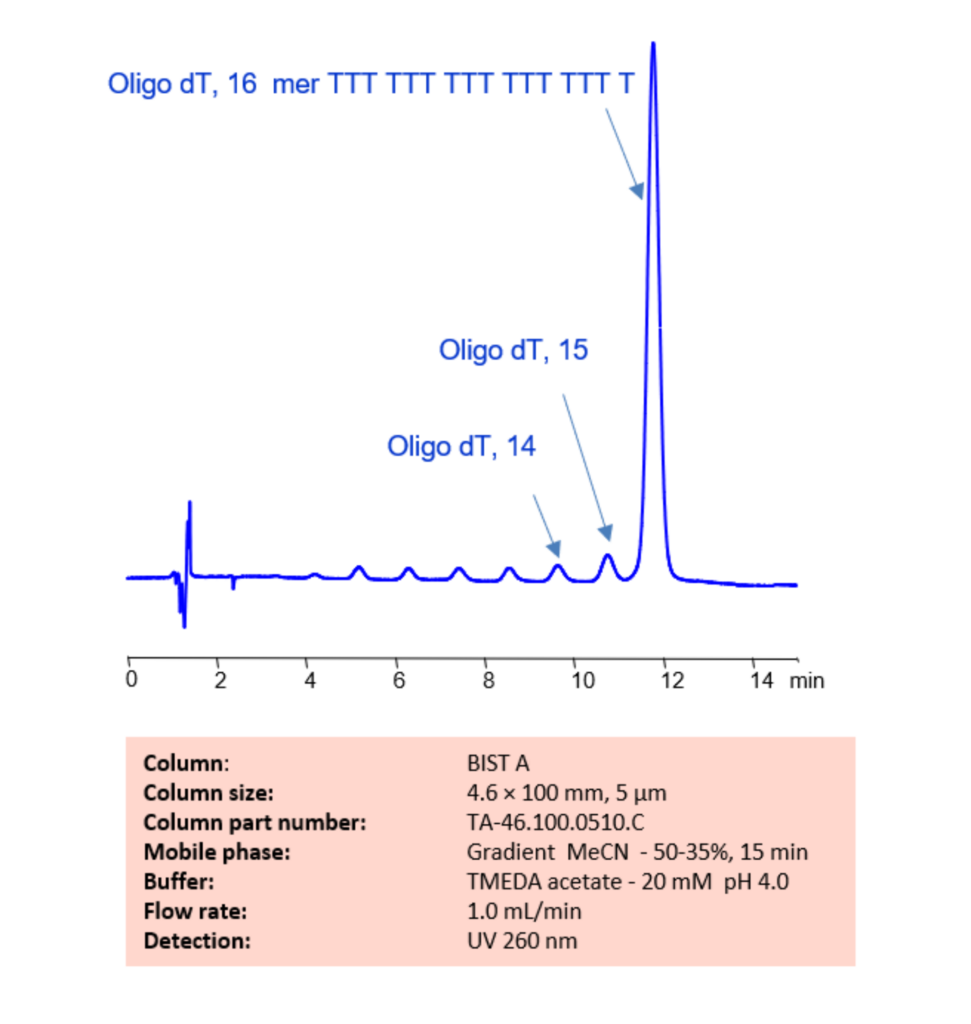
High Performance Liquid Chromatography (HPLC) Method for Analysis of Oligonucleotides
16 T oligonucleotides are short DNA molecules that consist of 16 thymine (T) nucleotides. They are commonly used in research and diagnostic applications, such as PCR (polymerase chain reaction), DNA sequencing, and gene expression analysis.
The sequence of a 16 T oligonucleotide is specific and unique, allowing it to be used as a primer or probe to target a specific DNA sequence of interest. When used in PCR, 16 T oligonucleotides can anneal to the complementary single-stranded DNA template and serve as a starting point for DNA polymerase to extend the DNA sequence.
Additionally, 16 T oligonucleotides have been used in the design of biosensors and other diagnostic tools due to their high specificity and sensitivity. They can also be modified with different chemical groups to enhance their stability and binding affinity.
Overall, 16 T oligonucleotides are valuable tools in molecular biology and genetics research, enabling scientists to amplify, sequence, and detect specific DNA sequences with high accuracy and precision.
Using SIELC’s newly introduced BIST™ method, this oligonucleotide can be retained on a negatively-charged, cation-exchange BIST™ A column. There are two keys to this retention method: 1) a multi-charged, positive buffer, such as TMEDA formate, which acts as a bridge, linking the negatively charged dye to the negatively-charged column surface and 2) a mobile phase consisting mostly of organic solvent (such as MeCN) to minimize the formation of a solvation layer around the charged analytes. Using this new and unique analysis method, oligonucleotide can be separated, retained, and detected at 260 nm.
Please read more on oligonucleotides analysis by HPLC in our April’s 2023 newsletter.
Condition
| Column | BIST A, 4.6 x 100 mm, 5 µm, 100 A, surface coated |
| Mobile Phase | Gradient MeCN – 50-35%, 15 min |
| Buffer | TMEDA acetate pH 4.0 – 20 mM |
| Flow Rate | 1.0 ml/min |
| Detection | UV 260 nm |
Description
| Class of Compounds | Oligonucleotides |
| Analyzing Compounds | Oligonucleotides |
Application Column
BIST A
Column Diameter: 4.6 mm
Column Length: 100 mm
Particle Size: 5 µm
Pore Size: 100 A
Column options: surface coated

